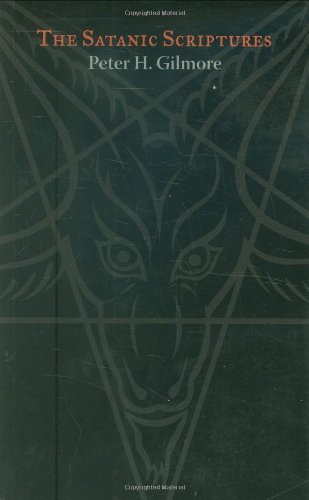
The Description, Philosophies and Justification of Satanism
http://www.dpjs.co.uk/satanism.html
By Vexen Crabtree 2010
Pages:
What are 'Left Hand Path' Religions? (2016)
Masters of Existence: Subjectivism and Self Worship in Satanism (2015)
The Causes of Satanism (2014)
The Pro-Blasphemy Position: Satanism in Action! (2008)
Animal Sacrifice and Blood Rituals in Traditional World Religions and Satanism (2008)
Satanism and Love (2006)
Satanism: The Natural Religion (2005)
Satanism: The Worship of Truth (2005)
Words that Satanists Don't Like (2003)
True, Real and Traditional Satanism (2003)
Satanism: The Profane Religion (2003)
The Satanic Mind is Balanced (2002)
Solipsism and Greater Magic in LaVeyan Satanism (2002)
Satan Represents Doubt: Satanic Epistemology (2002)
Satanism and Happiness (2002)
The Religion of the Flesh (2002)
Good is Derived from Evil: Satanic Theory (2002)
Satanism and Elitism: The Alien Elite (2002)
The Church Of Satan (2002)
Satanic Government and the Distrust of Human Nature (2001)
Satanic Life Power (2000)
How to Kill God and Reduce Religion (2000)
Devil Worship (1999)
Selling Your Soul to Satan: A How-To Manual (1999)
History:
The Knights Templar (2004)
Historical Satanism (2004)
The Black House: Pre-Demolition Photos from 2001 (2001)
Misc:
Litanies of Satan (expressive poetry)
- Satanism in Two Paragraphs
- Some Opening Declarations
- Classifications, Keywords and Sociological Definitions of Satanism
- The Satanic Bible
- External Links
- Links
1. Satanism in Two Paragraphs
#anton_lavey #church_of_satan #satanism
Satanism is a ferocious religion based on materialism, the empowerment of the self and the ego, the carnal realities of animal life, the questioning of social taboos, the ridiculing of most other religions, and the promotion of tough social justice. Satan is not real but is the most ideal and accurate symbol of reality and nature: The world is full of violence, suffering, stress, striving and death - the life cycle itself requires all these things. It is clear that no symbol of 'goodness' or 'light' can embody it all. The vast, uninhabitable darkness of the Universe, with galactic cataclysms rendering huge destructions on huge scales, means that only Satan can embody the true state of everything that is. Satanists tend to use all the symbols of darkness and evil. There is no heaven, no hell, no afterlife, no angels or demons: there are no gods or saviours apart from ourselves. But if there was a god, it would surely be utterly evil.
The Church of Satan was founded in 1966 by Anton LaVey and as of 2001 its Black Pope has been the powerful and articulate Peter Gilmore. Satanism as religion is highly skeptical, rationalist and philosophical, demanding evidence and strong argumentation, but is otherwise open-minded on magic and some parts of the supernatural. Satanists are often bold, intelligent, demanding; but are also often subtle, cautious, hidden, while others still are outrageous, aggressive, angry and puzzling. It is a religion of fire, drama, depth and forceful progress.
2. Some Opening Declarations
“There is no heaven of glory bright, and no hell where sinners roast. Here and now is our day of torment! Here and now is our day of joy! Here and now is our opportunity! Choose ye this day, this hour, for no redeemer liveth!”
"The Satanic Bible" by Anton LaVey (1969)1
The Book of Satan IV:2
 From Peter Gilmore, the High Priest of the Church of Satan:
From Peter Gilmore, the High Priest of the Church of Satan:
“Satanism has been defined. It does not allow for distortions such as belief in cosmic entities, animal sacrifice, or claims that one is a "demon incarnate" amongst other theistic delusions.”
"The Satanic Scriptures" by Peter Gilmore (2007)2
 LaVey also describes Satanism as a social engineering exercise:
LaVey also describes Satanism as a social engineering exercise:
“My brand of Satanism is the ultimate conscious alternative to herd mentality and institutionalized thought. It is a studied and contrived set of principles and exercises designed to liberate individuals from a contagion of mindlessness that destroys innovation. I have termed my thought "Satanism" because it is most stimulating under that name. Self-discipline and motivation are effected more easily under stimulating conditions. Satanism means "the opposition" and epitomizes all symbols of nonconformity. Satanism calls forth the strong ability to turn a liability into an advantage, to turn alienation into exclusivity. In other words, the reason it's called Satanism is because it's fun, it's accurate, and it's productive.”
"The Devil's Notebook" by Anton LaVey (1992)3
3. Classifications, Keywords and Sociological Definitions of Satanism
#atheism #dualism #humanism #left_hand_path #materialism #moojan_momen #mystery_religions #satanism
There are so many ways or organizing religions and beliefs, and so few religions fit neatly into categories, that I must present a list of key terms without attempting to order them into a coherent order. Hover over bits of the text for relevant links:
Not dualistic: souls and bodies are indivisible and there is no war between cosmic good and cosmic evil.
Autodeist - we worship ourselves. The only God we can ever perceive is in our own existential world. We are each a God.
Materialistic.
A "human potential" movement. Striving for longer life and a better education. Science And Technology Are Necessary: We who walk this dark path along with the same interests will pursue the elimination of Human limitation to the maximum.
Satanism is a World-Affirming Religion, not a World-Renouncing One.
Melton & Moore's 8 Religious Categories: Satanism's Position: Metaphysical.
Some pages about what Satanism is not:
A sensible one-paragraph description of Satanism can be found in the writings of a scholar of comparative religion, Jesper A. Petersen:
“Rationalist Satanism is an atheistic, sceptical, epicurean materialism as formulated by Anton Szandor LaVey in The Satanic Bible and other writings, and then expounded upon by a host of spokespersons in the following years. [The Church of Satan does] consider Satan to be a symbol of rebellion, individuality, carnality and empowerment, and Satanism the material philosophy best suited for the 'alien elite'; catchwords are indulgence, vital existence and rational self-interest. Although ritual practices are described and an ambiguous diabolical anthropomorphism or mystical deism is present from time to time, both are interpreted as metaphorical and pragmatic instruments of self-realization. Science, philosophy and intuition are advocated as authority, and productive non-conformity the highest goal of the individual.”
"Contemporary Religious Satanism" by Jesper Aagaard Petersen (2009)4
4. The Satanic Bible
 The Satanic Bible1 was written by Anton LaVey in 1969. There are 4 books in the Satanic Bible:
The Satanic Bible1 was written by Anton LaVey in 1969. There are 4 books in the Satanic Bible:
The Book of Satan. A poetic presentation of the character and aggression of Satanism. It is taken from the words of Ragnar Redbeard.
The Book of Lucifer. The Enlightenment. The philosophical and conceptual basis of Satanism.
The Book of Belial. The theory and practice of Satanic ritual, magic and psychology.
The Book of Leviathan. Texts for use in Satanic rituals. The Enochian Keys, translated by LaVey from the 17th Century texts of the deluded seer John Dee and assistant Edward Kelly.
In an academic book of Satanism, "Contemporary Religious Satanism" by Jesper Aagaard Petersen (2009)5, James R. Lewis examines the actual role that The Satanic Bible plays in Satanic debate, and concludes what should by now be obvious:
“Satanists do not consciously regard The Satanic Bible in the same way traditional religionists regard their sacred texts. [...] However, The Satanic Bible is treated as an authoritative document, which effectively functions as scripture within the Satanic community. In particular, LaVey's work is quoted to legitimate particular positions as well as to de-legitimate the positions of other Satanists.
James R Lewis in
"Contemporary Religious Satanism" by Jesper Aagaard Petersen (2009)6
Some scriptural analysis:
Introduction to The 4 Books of the Satanic Bible The Book Of Satan - The first book in the Satanic Bible Book Of Satan 1:1-4 - The first 4 verses of chapter 1 Book of Satan 1:5-7 - Verses 4 to 7 of chapter 1 |
5. External Links

Description, Philosophies and Justification of Satanism
Feral House - The publisher that refuses to be domesticated
